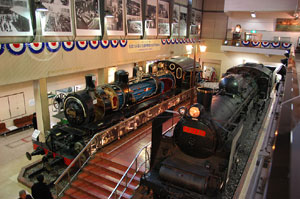The Last days of Japanese Steam Engines
Part 2The Final Passenger Steam Train.
14th December 1975
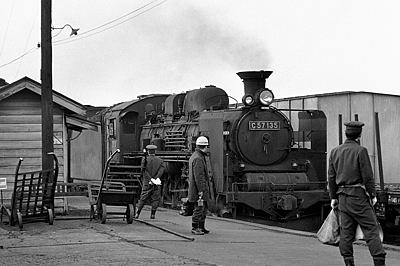
|
|
Arriving at Oiwake with a Iwamizawa to Muroran train C57_135 on Mar, 1970. |
|
The last special passenger train, named, "Good-bye to Steam" ran on December 14, 1975 on Muroran line
Muroran to Iwamizawa with class C57 No.135.
The day before on the 13th of December 1975 at 2:03 p.m., C57_135 was deadheaded from Iwamizawa depot to Muroran depot in front of a DD51 diesel freight train. It arrived at 6 p.m., but already many of the Rail-Fans and news media were waiting. From 7 p.m., C57_135 was decorated with the Good-By-Steam-Train plate etc .... And the the engine was sparkling clean. C57_135 was manufactured at Mitsubishi Heavy Industry during 27th May 1940. It's manufactured number was 285. After its inception, C57_135 was deployed to the Takasaki depot, and it was mainly active on the Takasaki line. Later she was moved to Hokkaido's Otaru-Chikko depot, during Takasaki's electrification on 20 Aug 1952, after which, she was on the Hakodate line. Later, she was transfered to Muroran during May 1969, and finally C57_135 was moved to her last depot ...... Iwamizawa, during January 1970. C57_135 was active on the Muroran line passenger train service until her last day. On the last day, the 14th of December 1975 06:30 a.m., C57_135 pulled out from the roundhouse, and loaded coal and water. At that juncture, there were already about 120 people wanting to ride on the Good-By-Train and had been waiting throughout the night. The number of individuals ballooned to two thousand by 7:30 a.m. Muroran station became extremely crowded. At 7:36 a.m., C57_135 was deadheaded to Muroran station. Afterward a short ceremony was held on Muroran station's platform. After JNR administration officer Mr. Ibuka and Mr. Sekigawa head of the General Directorate of Hokkaido gave their speech, a little girl named Imano of 13 years and Kuramoto, a girl of 7 years, brought a bouquet of flowers to the engineer and stoker. At 7:58 a.m., the song Auld Lang Syne (Auld Lang Syne is a farewell song in Japan) was played at the station. C57_135 while pulling the Good-By-Steam train departed Muroran station with only a 8 minute delay. Eight passenger cars carried 2,000 people and the car's interior condition was so overcrowded that no one could stir an inch. Fifty passengers were left behind on Muroran's platform. Throngs of people lined the sides of the tracks all the way to Tomakomai.... it consisted of local people as well as those of the media. The train arrived at Tomakomai after a 38 minute delay. Finally, the last steam passenger train arrived at Iwamizawa with a 74 minute delay. It was 2 p.m. on the 14th of December 1975. After Iwamizawa city mayor Mr. Kunikane gave a speech, C57_135 was unhooked from the cars and moved to Iwamizawa depot. After which it dropped fire forever. According to the 14th of Dec 1975 newspaper, the total along the railway line attracted 25,000 people, and those who boarded an got off totaled 4,200.
| 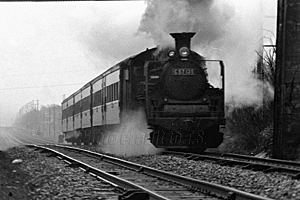
C57_135 running from Toasa on the Muroran line. Mar 1971 |
|
C57_135 was waiting to transfer to the Tokyo Transportation Museum in Iwamizawa depot's shed.
At first, the transfer date was the 25th of March, but it was repeatedly changed because of the strike.
Finally, the transfer date was decided to be the 4th of April.
During that time, her crossed off registration was effective on the 31st of March 1976.
During the early morning of April 4th at 4:36 a.m., C57_135 departed uproute from her home station at Iwamizawa. On the 6th of April, she was taken aboard the Seikan ferry-boat in Hakodate at 5:20 p.m., and left from Hokkaido. C57_135 passed through Aomori, Sendai and arrived at the Omiya yard on the 8th of April 00:23 a.m. According to the original plan, C57_135 was split apart at the Omiya yard, and was to be moved to the Museum by a large truck. But the plan was changed and it was sent to the Tabata Tokyo terminal by rail.. C57_135 arrived at the Tabata terminal on the 24th of April 1976. During the 24th of April, the engine, cab and tender were disassembled, and the tender and cab were placed on board a large truck, and transported to Tokyo's downtown Transportation Museum at Manseibashi at 3:30 p.m. On the morning of the next day, the engines's boiler and travel unit were disassembled, and transported to the museum. |
C57_135 arriving at Tokyo's Tabata terminal
During 24 Apr 1976
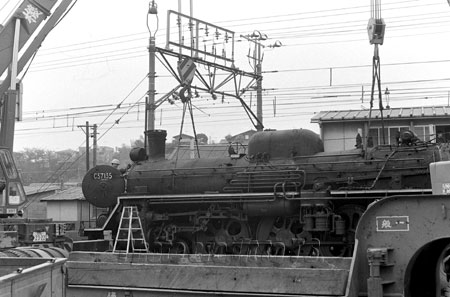
|
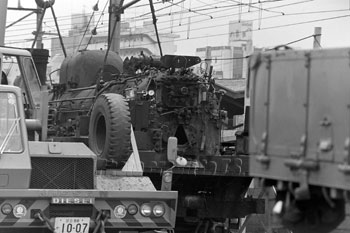
|
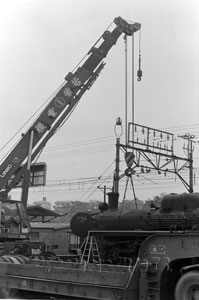
|
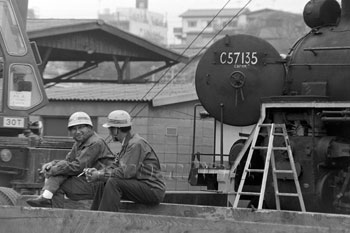
|
On the 25th at the museum, the tender and cab were carried into the museum building and the tender was rebuilt. On the 26th, the boiler and the travel unit were carried into the building, and they were reassembled. All of the assembling was completed during the same day on the 26th. From the next day, their makeup was started and was finished on the 13th day of May.
The new museum was reopened on the 14th of October 2007, at Omiya city Saitama prefecture. C57_135 was also moved to a new location in Saitama. |
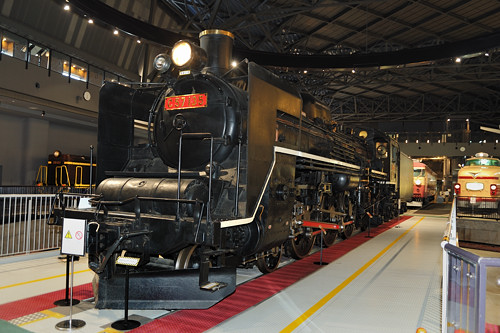
Exhibited C57_135
Saitama Railway Museum, Apr 2009.
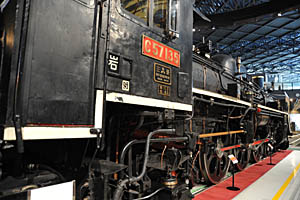
|
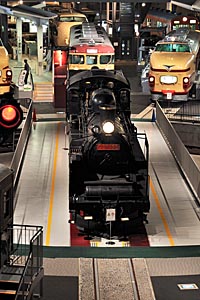
|
Other surviving C57s
| C57 38 | |||||||||||||||||||
|
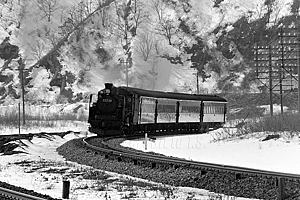
C57_38 Noboribetu, Muroran line. |
| C57 44 | ||||||||||||
|
| C57 57 | |||||||||||||||
|
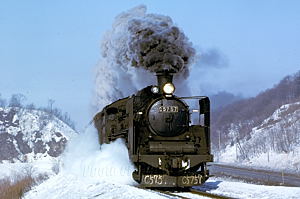
C57_57 Kurioka, Muroran line |
| C57 135 | |
| See body text. |
| C57 144 | |||||||||||||
|
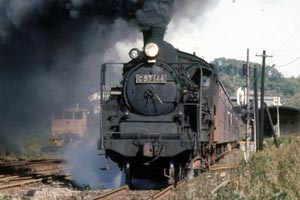
C57_144 Noboribetsu, Muroran line (Photo credit to Nicholas Pertwee) |

|

|

|
| After a one year period | Final Main Line service |
